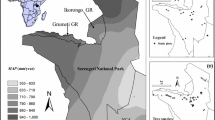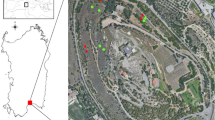Abstract
Conyza bonariensis is an invasive weed of increasing importance in subtropical and warm-temperate regions worldwide, both in non-agricultural habitats and in annual and perennial crops, especially under no-till management. To gain insigths on basic life cycle processes determining the demographic success of C. bonariensis, we studied for this species during two seasons seedling emergence patterns, survival to the adult stage and fecundity in a ruderal Mediterranean habitat in which C. bonariensis was a component of the plant community. The influence of emergence date on survival and fecundity was studied using four successive sowing dates, i.e. cohorts, encompassing the favorable season for plant establishment. The mean rate of seedling emergence was 61%. Emergence patterns were characterized by high initial emergence rates, which were highly dependent on rainfall. The mean rate of survival to the adult stage was 33%. Fecundity reached a mean value of 86,066 achenes and presented density-dependent regulation.. Plant survival and fecundity were positively related to cohort earliness and thus earlier cohorts should preferably be targeted for an effective management of C. bonariensis.





Similar content being viewed by others
References
Bhowmik, P. C., & Bekech, M. M. (1993). Horseweed (Conyza canadensis) seed production, emergence, and distribution in no-tillage and conventional tillage corn (Zea mays). Agronomy, 1, 67–71.
Borger, C. P., Scott, J. K., Walsh, H. M., & Powles, S. B. (2009). Demography of Salsola australis populations in the agricultural region of south-west Australia. Weed Research, 49, 391–399.
Bosnic, A. C., & Swanton, C. J. (1997). Influence of barnyardgrass (Echinochloa crusgalli) time of emergence and density on corn (Zea mays). Weed Science, 45, 276–282.
Buhler, D. D. (1995). Influence of tillage systems on weed population dynamics in corn and soybean in the central USA. Crop Science, 35, 1247–1258.
Buhler, D. D., & Owen, M. D. (1997). Emergence and survival of horseweed (Conyza canadensis). Weed Science, 45, 98–101.
Cousens, R., & Mortimer, M. (1995). Dynamics of weed populations (p. 332). New York: Cambrige University Press.
Dauer, J. T., Mortensen, D. A., & Vangessel, M. J. (2007). Temporal and spatial dynamics of long-distance Conyza canadensis seed dispersal. Journal of Applied Ecology, 44, 105–114.
Fernandez-Quintanilla, C., Navarrete, L., Gonzalez-Andujar, J. L., Fernandez, A., & Sanchez, M. J. (1986). Seedling recruitment and age-specific survivorship and reproduction in populations of Avena sterilis ssp. ludoviciana. Journal of Applied Ecology, 23, 945–955.
Firbank, L. G., & Watkinson, A. R. (1986). Modelling the population dynamics of an arable weed and effects upon crop yield. Journal of Applied Ecology, 23, 147–159.
Gallart, M., Mas, M. T., & Verdú, A. M. (2010). Demography of Digitaria sanguinalis: Effect of the emergence time on survival, reproduction, and biomass. Weed Biology and Management, 10, 132–140.
Gonzalez-Andujar, J. L., & Fernandez-Quintanilla, C. (1991). Modelling the population dynamics of Avena sterilis in winter wheat production under dry-land cereal cropping systems. Journal of Applied Ecology, 28, 16–27.
Gonzalez-Andujar, J. L., & Fernandez-Quintanilla, C. (1993). Strategies for the control of Avena sterilis in winter wheat production systems in central Spain. Crop Protection, 12, 617–623.
Gonzalez-Andujar, J. L., Plant, R. E., & Fernandez-Quintanilla, C. (2001). Modeling the effect of farmers’ control decisions on the population dynamics of winter wild oat (Avena sterilis ssp ludoviciana) in an agricultural landscape. Weed Science, 49, 414–422.
Gramshaw, D., & Stern, W. R. (1977). Survival of annual ryegrass (Lolium-rigidum-gaud) in a mediterranean type environment. 1. Effect of summer grazing by sheep on seed numbers and seed-germination in autumn. Australian Journal of Agricultural Research, 28, 81–91.
Green, T. D. (2010). The ecology of fleabane (Conyza spp.). PhD Thesis. University of New England. Australia.
Holm, L. G., Doll, J., Holm, E., Pancho, J., & Herbeger, J. (1997). World weeds: natural histories and distribution (p. 1129). Toronto: Wiley.
Izquierdo, J., Gonzalez-Andujar, J. L., Bastida, F., Lezaun, J. A., & Sanchez del Arco, M. J. (2009). A Thermal Time Model to Predict Corn Poppy (Papaver rhoeas) emergence in cereal fields. Weed Science, 57, 660–664.
Karlsson, L. M., & Milberg, P. (2007). Comparing after-ripening response and germination requirements of Conyza canadensis and Conyza bonariensis (Asteraceae) through logistic functions. Weed Research, 47, 433–441.
Kempen, H. M., & Graf, J. (1981).Weed seed production. Proc.West. Soc. Weed Sci. 17–19 March. San Diego, California (pp. 78–81).
Kiegel, J. (1995). Seed germination in arid and semiarid regions. In J. Kiegel (Ed.), Seed Dormancy and Germination (pp. 645–700). New York: Marcel Dekker, Inc..
Knezevic, S. Z., & Horak, M. J. (1998). Influence of emergence time and density on redroot pigweed (Amaranthus retroflexus). Weed Science, 46, 665–672.
Marshall, E. J. P. (1989). Distribution Patterns of Plants Associated with Arable Field Edges. Journal of Applied Ecology, 26, 247–257.
Ming-Xun, R., Xiao-Qiong, L., & Jian-Qing, D. (2010). Genetic variation and spread pattern of invasive Conyza sumatrensis around China’s Three Gorges Dam. Acta Oecologica, 36, 599–603.
Mokhtassi-Bidgol, I. A., Navarrete, L., Aghaalikhani, M., & Gonzalez-Andujar, J. L. (2013). Modelling the population dynamic and management of Bromus diandrus in cereal. Weed Research, 43, 128–133.
Mulugeta, D., & Stoltenberg, D. E. (1997). Seed bank characterization and emergence of a weed community in a moldboard plow system. Weed Science, 45, 54–60.
Nandula, V. K., Eubank, T. W., Poston, D. H., Koger, C. H., & Reddy, K. N. (2006). Factors affecting germination of horseweed (Conyza canadensis). Weed Science, 54, 898–902.
Norris, R. F. (1996). Morphological and phenological variation in barnyardgrass (Echinochloa crus-galli) in California. Weed Science, 44, 804–814.
Palmblad, I. G. (1968). Competition in experimental populations of weeds with emphasis on the regulation of population size. Ecology, 49, 26–34.
Prieur-Richard, A., Lavorel, S., Grigulis, K., & Dos Santos, A. (2000). Plant community diversity and invasibility by exotics: invasion of Mediterranean old fields of Conyza bonariensis and Conyza canadensis. Ecology Letters, 3, 412–422.
Puricelli, E., Orioli, G., & Sabbatini, M. R. (2002). Demography of Anoda cristata in wide- and narrow-row soyabean. Weed Research, 42, 456–463.
Regehr, D. L., & Bazzaz, F. A. (1979). The population dynamics of Erigeron canadensis, a successional winter annual. Journal of Ecology, 67, 923–933.
Schippers, P., & Joenje, W. (2002). Modelling the effect of fertiliser, mowing, disturbance and width on the biodiversity of plant communities of field boundaries. Agriculture, Ecosystems & Environment, 93, 351–365.
Shrestha, A., Hembree, K., & Wright, S. (2008). Biology and management of horseweed and hairy fleabane in California. University of California, ANR Publication 8314. pp. 1–9.
Shrestha, A., Hanson, B. D., Fidelibus, M. W., & Alcorta, M. (2010). Growth, phenology, and intraspecific competition between glyphosate-resistant and glyphosate-susceptible horseweeds (Conyza canadensis) in the San Joaquin Valley of California. Weed Science, 58, 147–153.
Thébaud, C., Finzi, A. C., Affre, L., Debussche, M., & Escarré, J. (1996). Assessing why two introduced Conyza differ in their ability to invade Mediterranean old fields. Ecology, 77, 791–804.
Torra, J., & Recasens, J. (2008). Demography of corn poppy (Papaver rhoeas) in relation to emergence time and crop competition. Weed Science, 56, 826–833.
Trezzi, M. M., Vidal, R. A., Patel, F., Miotto Junior, E., Debastiani, F., Balbinot Junior, A. A. & Mosquen, R. (2015). Impact of Conyza bonariensis density and establishment period on soyabean grain yield, yield components and economic threshold. Weed Res, 55, 34–41
Urbano, J. M., Borrego, A., Torres, V., Leon, J. M., Jimenez, C., Dinelli, G., & Barnes, J. (2007). Glyphosate-resistant hairy fleabane (Conyza bonariensis) in Spain. Weed Technology, 21, 396–401.
Verdú, A. M., & Mas, M. T. (2006). Cohort-dependent seedling recruitment, survival and reproductive capacity of Tribulus terrestris. Weed Research, 46, 371–378.
Vivian, R., Gomes, J. R., Chamma, H. M., Silva, A. A., Fagan, E. B., & Riuz, S. T. (2008). Efeito da luz e da temperatura na germinacao de Alternathera tenella, Conyza bonariensis e Digitaria ciliaris. Planta Daninha, 26, 507–513.
Widderick, M., Walker, S., & Cook, T. (2012). Flaxleaf fleabane (Conyza bonariensis)-strategic solutions using best management practice. Pakistan Journal of Weed Science Research, 18, 687–693.
Wu, H., & Walker, S. (2004). Fleabane biology and control. In S. R. Walker, M. Widderick, & H. Wu (Eds.), Fleabane: workshop proceedings (pp. 5–6). Toowoomba: CRC for Australian Weed Management.
Wu, H., Walker, S., Rollin, M. J., Tan, D. K., Goeuff, R., & Werth, J. (2007). Germination, persistence, and emergence of flaxleaf fleabane (Conyza bonariensis [L.] Cronquist). Weed Biology and Management, 7, 192–199.
Wu, H., Walker, S., Robinson, G., & Coombers, N. (2010). Control of Flaxleaf Fleabane (Conyza bonariensis) in Wheat and Sorghum. Weed Technology, 24, 102–107.
Yamashita, O. M., & Guimarães, S. C. (2010). Germinação das sementes de Conyza canadensis e Conyza bonariensis em função da disponibilidade hídrica no substrato. Planta Daninha, 28, 309–317.
Zambrano-Navea, C., Bastida, F., & Gonzalez-Andujar, J. L. (2013). A hydrothermal seedling emergence model for Conyza bonariensis. Weed Research, 53, 213–220.
Acknowledgements
This work was supported by grant AGL2009-7883 of the FEDER (European Regional Development Funds) and of the Spanish Ministry of Economy and Competitiveness (MINECO). CZ-N acknowledges a scholar grant from CDCH-UCV (Council of Scientific and Humanistic-Central University of Venezuela).
Author information
Authors and Affiliations
Corresponding author
Rights and permissions
About this article
Cite this article
Zambrano-Navea, C., Bastida, F. & Gonzalez-Andujar, J.L. Demography of Conyza bonariensis (Asteraceae) in a ruderal Mediterranean habitat. Phytoparasitica 46, 263–272 (2018). https://doi.org/10.1007/s12600-018-0647-9
Received:
Accepted:
Published:
Issue Date:
DOI: https://doi.org/10.1007/s12600-018-0647-9




